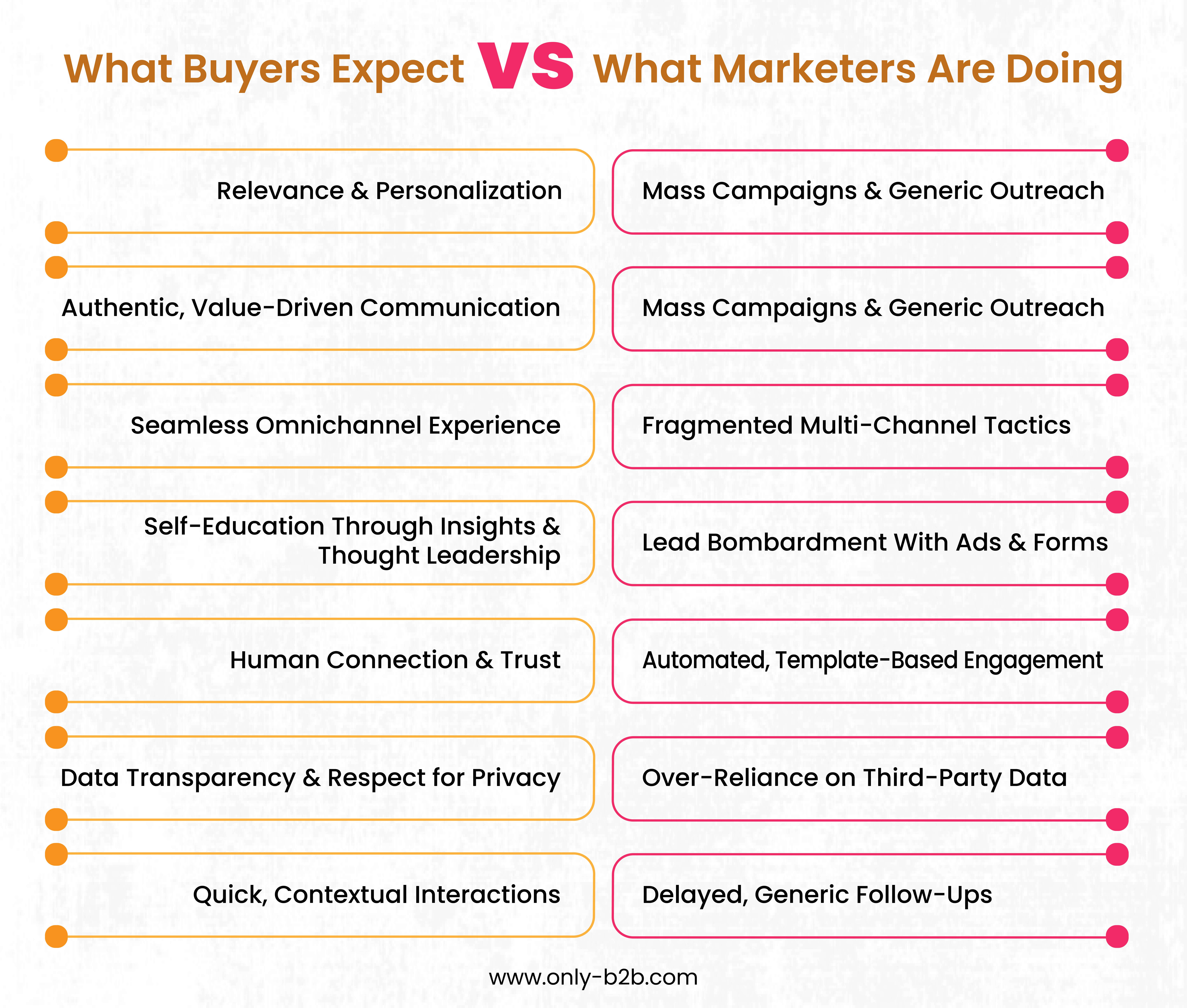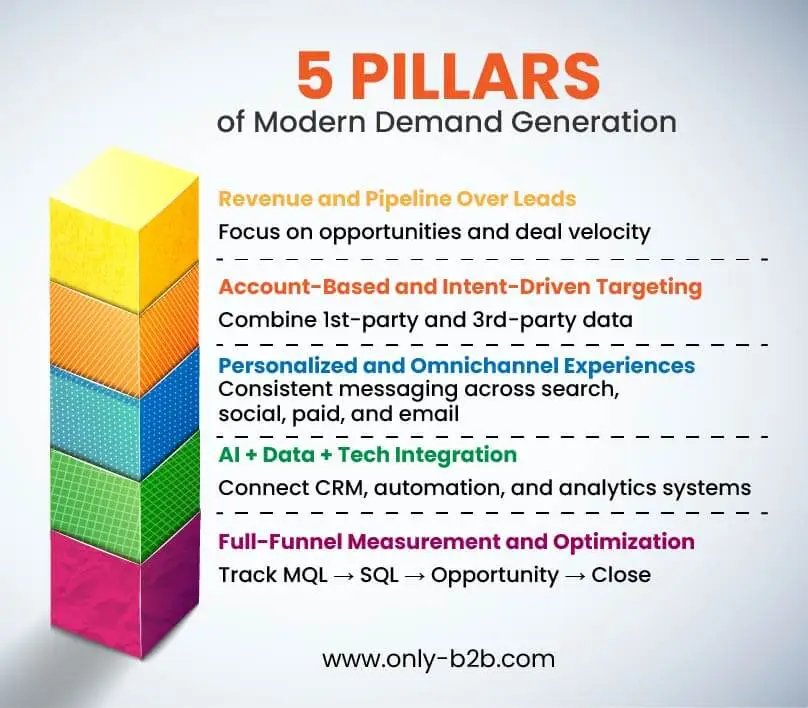79% of marketers say their AI strategy isn’t aligned with business goals.
Are you part of that 79%? Is your current AI stack driving business or just speeding up processes?
Nowhere is this disconnect clearer than in B2B demand generation. The days are gone when marketing teams measured success by the number of leads handed to sales.
Today, this playbook is more like history, good to study but not to implement. Buyers today are more informed, their journeys are nonlinear, and their expectations are higher than ever. The days of gated eBooks and mass email blasts defining growth are over.
A new model has emerged. It is built on being account-centric, data-driven, and revenue-aligned.

The Old Model: When Demand Generation Was Just Lead Generation
Table of Contents
Demand generation once meant collecting names:
- Run a webinar
- Gate an eBook
- Buy a list
- Push an offer
That is exactly what we did. And honestly, some still do it. The older playbook was simple, sorted, and no fuss.
If form fills came in, marketing declared victory. Sales took over, hoping some of those names would become customers.
And yes, it worked in a quieter, simpler market. Buyers needed vendors for information, and competition was thin.
As digital channels expanded, cracks began to show:
- Lead volumes grew while conversions dropped
- Buyers began self-educating long before contacting vendors
- Sales lost faith in lead quality
- Marketing faced pressure to prove revenue impact
The funnel changed, but the strategy did not.
Why the Old Playbook Collapsed
1. Buyers Took Control
Over 50% of large B2B purchases now happen through digital self-serve channels. That means half of your potential pipeline forms before buyers ever speak to you.
To form their opinions, they seek out reviews, join peer communities, and gather insights long before a sales rep reaches them.
You might ask, “Is our website and content strong enough to guide them independently?”
To stay relevant, you must meet buyers earlier in their journey, not with aggressive outreach but with valuable insight.
The first impression should not be a sales email; it should be a solution that helps them define their problem.
2. Complex Buying Groups, Longer Cycles
A single B2B deal can involve six to ten decision-makers across departments such as IT, procurement, finance, and operations. Too many opinions create too many challenges.
On top of that, the buyer’s path loops between channels, conversations, and content, yet our funnel still looks linear.
You should redesign your demand engine to educate and influence every stakeholder throughout the process, not just attract one lead. Guide them without pushing. Lead with nurturing and clarity, not just clicks.
3. The Data Dilemma
73% of B2B marketers say their data-driven programs are only “somewhat successful.”
We have plenty of dashboards, reports, and analytics tools, but many teams lose potential by getting lost in spreadsheets.
Data shortage isn’t the issue. Data disconnection is. You may collect signals such as intent data, web behavior, and CRM insights, but are you using them effectively?
Technology alone isn’t the answer. Strategy, alignment, and disciplined governance are equally important.
Data should guide you, not overwhelm you. When you use it to anticipate buyer needs instead of justifying past performance, your marketing stops reacting and starts leading.
4. The Pressure for Revenue Accountability
Top-performing firms now measure marketing by pipeline and revenue, not lead count.
“That’s exactly what leadership keeps telling us: ‘Show me the pipeline impact.’”
This shift has transformed marketing from a support function into a strategic growth partner. Every campaign must prove its influence on pipeline creation, velocity, and deal size.
For marketing teams, this isn’t a burden. It is an opportunity. It is a chance to earn a seat at the revenue table, to shape conversations, and to prove impact beyond awareness.
5. Personalization Is the New Standard
Short-form videos and interactive tools now outperform gated PDFs for B2B engagement.
That’s what your audience is saying, “Don’t talk at me. Engage me.”
Today’s buyers crave authenticity, relevance, and connection. They expect every interaction to recognize who they are, what they need, and where they are in their journey.
Personalization isn’t optional anymore. It has become a basic expectation. The brands that thrive make every touchpoint feel personal, from dynamic website experiences to contextual ad messaging, all powered by clean data and thoughtful storytelling.
The Modern Demand Generation Framework
Modern demand generation isn’t about filling funnels. It’s about building systems that drive sustainable revenue.
The new framework rests on five pillars:
1. Revenue and Pipeline Over Leads
The days of measuring marketing by lead counts are gone.
Today, success is defined by:
- Pipeline sourced
- Opportunities created
- Deal velocity and value
Marketing now owns influence across the full funnel, from awareness to renewal. That requires close collaboration with sales, shared dashboards, and unified KPIs.
When both teams measure what matters, marketing stops chasing volume and starts accelerating growth.
2. Account-Based and Intent-Driven Targeting
Broad targeting wastes budget. The smartest programs focus on accounts showing clear intent, meaning companies already researching relevant topics or competitors.
According to LeadSpot, syndicated intent leads convert three to four times higher than generic paid leads.
By combining:
- First-party data (your CRM, website, or engagement history)
- Third-party intent signals (topic research or competitor interest)
Marketers can identify the accounts most likely to buy and tailor outreach accordingly. It is precision over presence, resulting in fewer but better conversations that move deals forward.
3. Personalized and Omnichannel Experiences
B2B buyers expect consistency across every channel. Whether it’s a blog, a LinkedIn ad, or a webinar, the message should feel cohesive and relevant.
Modern demand generation connects organic search, paid media, social engagement, and email nurturing into one orchestrated experience.
Content has evolved too. Short videos, podcasts, and interactive tools now outperform static whitepapers because they engage curiosity instead of demanding commitment.
When marketers design experiences that educate and inspire, they build trust, and trust drives revenue.
4. AI + Data + Tech Integration
Only 34% of marketers feel confident in their data’s accuracy.
That isn’t a data problem; it’s a workflow problem.
Disconnected systems create fragmented visibility. A modern demand engine connects CRM, marketing automation, intent data, and analytics platforms into one ecosystem.
AI and predictive analytics then add intelligence by helping teams prioritize accounts, personalize content, and optimize spend. Integration does more than create efficiency; it creates clarity. Clarity means knowing what’s working, what’s not, and where to invest next.
5. Full-Funnel Measurement and Optimization
The buyer journey doesn’t end at conversion; it extends through retention and expansion.
Modern marketers analyze every stage:
- MQL to SQL
- SQL to Opportunity
- Opportunity to Close
They track deal velocity, pipeline value, and cost per pipeline dollar. Attribution is multi-touch, insights are continuous, and success is measured by momentum, not just actions. When marketing understands the reason behind performance, it becomes truly strategic.

Building a Modern Demand Engine
Transitioning from a lead-centric model to a revenue engine begins with clarity. Audit your buyer journey, your technology, and your handoffs. Identify where engagement drops and data disconnects.
Next, define your ideal customer profile and the buying groups that influence purchase decisions. Align with sales on these targets and set shared pipeline goals.
Integrate systems to eliminate blind spots. Connect CRM, automation, and intent data so that insights flow freely between marketing and sales.
Then, design omnichannel campaigns that address each persona’s needs at every stage of the journey. Map your content around awareness, consideration, and decision, and deliver it in formats that encourage participation rather than just clicks.
Personalize every interaction, from email to retargeting, based on intent and engagement level. When buyers feel seen and understood, conversion follows naturally.
Finally, measure what matters. Track movement through the funnel, assess time-to-close, and analyze deal quality. Feed those learnings back into your ICPs and campaign design to continuously improve performance.
The Human Meaning Behind the Metrics
Technology may drive the new era of demand generation, but people still define it.
AI can predict intent, but only marketers can translate intent into empathy.
Data can show patterns, but only strategy can turn patterns into progress.
Modern demand generation is the harmony of both intelligence and intuition. It is where automation amplifies authenticity.
When marketing and sales move as one, when data clarifies instead of confuses, and when every campaign begins with empathy, the funnel stops being mechanical. It becomes meaningful.
That is when marketing stops generating leads and starts generating trust, the true currency of revenue.
Conclusion
B2B demand generation has entered a new era. Yes, your old playbook belongs in the scrap pile. We are in that transition now.
Ask yourself:
- Are you still operating with outdated lead-generation tactics?
- Still chasing volume over value?
- Still measuring success by the number of leads instead of the quality of pipeline?
If you are, it’s time to evolve. The demand engines that will win are those that use AI with authenticity, data with direction, and automation with alignment.
The question isn’t whether demand generation has changed. The question is whether your strategy has kept up.

Vikas Bhatt is the Co-Founder of ONLY B2B, a premium B2B lead generation company that specializes in helping businesses achieve their growth objectives through targeted marketing & sales campaigns. With 10+ years of experience in the industry, Vikas has a deep understanding of the challenges faced by businesses today and has developed a unique approach to lead generation that has helped clients across a range of industries around the globe. As a thought leader in the B2B marketing community, ONLY B2B specializes in demand generation, content syndication, database services and more.





